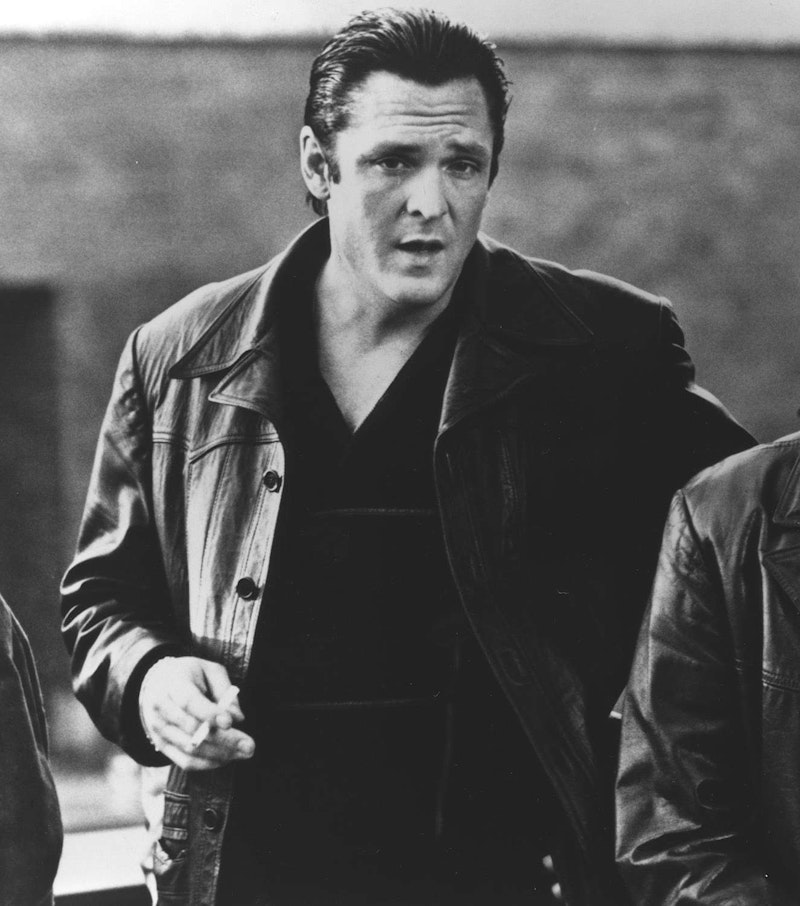There are few moments that revolutionized cinema overnight like the nauseating sequence in Reservoir Dogs, in which Mr. Blonde’s brutal torture of a police officer is scored to the sound of Stealer Wheel’s “Stuck In The Middle With You.” Quentin Tarantino’s debut feature left viewers dazzled with its eclectic popular culture references, but it didn’t skimp when given the opportunity to show how demented its rogue's gallery was. Mr. Blonde may have delivered some compelling points in the dispute about the ethics of tipping, but when left to his own devices, he didn’t shy away from any sadistic indulgences. The late Michael Madsen’s cool-as-ice performance jettisoned Reservoir Dogs into a modern classic.
Madsen was among Tarantino’s most reliable stars. Denying the role of Vincent Vega in Pulp Fiction, Madsen went on to play the titular antagonist in the Kill Bill duology, which made Uma Thurman’s revenge odyssey even more cathartic. Although Madsen had a small late-career resurgence with his role as cowboy Joe Gage in The Hateful Eight, the majority of his filmography is stacked with countless direct-to-VOD films, many of which appear to have been shot over a single weekend. This has become a common trend among actors like John Travolta, Bruce Willis, John Cusack, and Emile Hirsch among others within their twilight years, but to Madsen’s credit, he kept a healthy perspective about the quality of his output. “When people offered me work, it wasn't always the best,” he told The Independent. “I had to buy groceries and I had to put gas in the car.”
It wouldn’t be fair to claim that Tarantino was the sole reason for Madsen’s popularity. Between a stone-hearted detective in Robert Rodriguez’s Sin City, Susan Sarandon’s effortlessly chill boyfriend in Thelma & Louise, the performance artist Tom Baker in The Doors, and a ruthless killer in the underappreciated remake The Getaway, Madsen was often cast as seedy, dangerous guys. His value as a member of an ensemble may have in some ways done him a disservice, as Madsen delivered one of his best performances ever in the 1997 gangster thriller Donnie Brasco.
Donnie Brasco told the true story of the FBI Agent Joe Pistone (Johnny Depp), who took on the alias “Donnie” in order to infiltrate the inner circle of the mobster Benjamin Ruggiero (Al Pacino), known to both his friends and foes as “Lefty.” While Lefty was able to hide behind the persona of a kindly grandfather who still viewed the mafia as a time-honored American institution, Madsen breathed life into his ruthless underling, Sonny Black, a volatile member of the crew whose trigger-happiness made Mr. Blonde look like a pacifist in comparison.
Donnie Brasco explored the ways in which the mafia responded to its depiction in the media. Although The Godfather may have sensationalized the familial components of the dangerous trade, men like Sonny contested the suggestion that their work was anything but business. There may not have been a single “made man” who didn’t desire the power that Lefty possessed, but Sonny was one of the few who seemed capable. As grating as his paranoid suspicions could get, Sonny’s ability to sniff out potential turncoats sealed the cone of silence that aided the secrecy of Lefty’s operation.
Depp was once considered a quiet, sensitive actor who embodied fringe members of society. The irony of Donnie Brasco is that Johnny’s a lost soul who has little passion in his life, as the guise of Donnie unlocked a capacity for mischief that he had previously attempted to mask. While the paternalistic tragedy of Donnie and Lefty gave Donnie Brasco poetic grace, Madsen embodied the legitimate stakes of being involved with a violent world. There was never a question as to whether Sonny would be unleashed, as it was only a matter of time before his paranoid instincts were proven correct.
Even when compared to the eccentricity of Joe Pesci’s Tommy DeVito in Goodfellas or Robert De Niro’s Al Capone in The Untouchables, Madsen’s version of Sonny wasn’t the type of gangster character who could inspire an ironic appreciation. He captured the essence of a man whose life was staked on reputation, even if respect is something he wasn’t keen to show to others. It’s not quite admiration that illuminated Sonny’s relationship with Lefty, but rather an admission of satisfaction. A memorable scene in Donnie Brasco involved Sonny’s brutal execution of a rival mobster that had threatened Lefty’s sting; Madsen expressed Sonny’s violent actions as an obligation, his personal desire for revenge was entirely removed from the situation.
Madsen was the key to Donnie Brasco’s tone, as he offered a healthy perspective on what the tone of a “ripped from the headlines” crime biopic should be; while it took place in the 1970s, Donnie Brasco had more in common with the post-Goodfellas crime epics than the more studied thrillers of the New Hollywood era. If Pacino represented the past of crime fiction and Depp embodied the more artful direction that the genre was going, Madsen grounded the film in the immediacy of situational danger. Even if Donnie Brasco did provoke sweeping proclamations about the depiction of America’s seedy underbelly, a character like Sonny ensured that it was riveting on a scene-to-scene basis.
To call Madsen a “character actor” is appropriate, as even his most bottom-of-the-barrel credits would contain a few moments of brilliance. Donnie Brasco may not have been Reservoir Dogs was, but Madsen balanced the line between two generations of crime fiction, and provided one of cinema’s most chilling gangsters.

